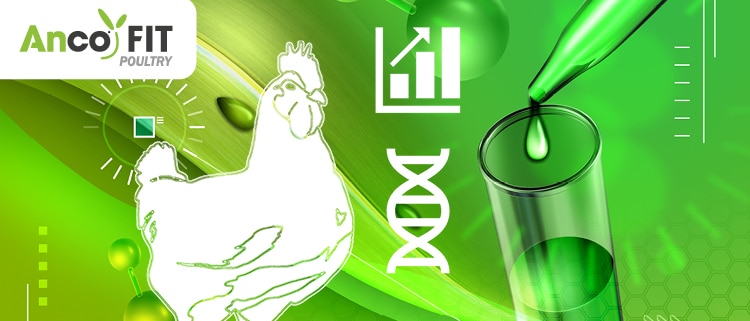Anco FIT Poultry proof of mode of action in broilers
Scientific proof of the mode of action of Anco FIT Poultry in broilers.
The Animal Nutrition journal published a scientific paper with research involving the application of Anco FIT Poultry in broilers and its effects on the expression of cytoprotective genes at the gut level.
Link to full scientific paper published online in Animal Nutrition
Abstract
Priming of intestinal cytoprotective genes and antioxidant capacity by dietary phytogenic inclusion in broilers
Konstantinos C. Mountzouris, Vasileios V. Paraskeuas, Konstantinos Fegeros
The potential of a phytogenic premix (PP) based on ginger, lemon balm, oregano and thyme to stimulate the expression of cytoprotective genes at the broiler gut level was evaluated in this study. In particular, the effects of PP inclusion levels on a selection of genes related to host protection against oxidation (catalase [CAT], superoxide dismutase 1 [SOD1], glutathione peroxidase 2 [GPX2], heme oxygenase 1 [HMOX1], NAD(P)H quinone dehydrogenase 1 [NQO1], nuclear factor (erythroid-derived 2)-like 2 [Nrf2] and kelch like ECH associated protein 1 [Keap1]), stress (heat shock 70 kDa protein 2 [HSP70] and heat shock protein 90 alpha family class A member 1 [HSP90]) and inflammation (nuclear factor kappa B subunit 1 [NF-kB1], Toll-like receptor 2 family member B (TLR2B) and Toll-like receptor 4 [TLR4]) were profiled along the broiler intestine. In addition, broiler intestinal segments were assayed for their total antioxidant capacity (TAC). Depending on PP inclusion level (i.e. 0, 750, 1,000 and 2,000 mg/kg diet) in the basal diets, 1-d-old Cobb broiler chickens (n = 500) were assigned into the following 4 treatments: CON, PP-750, PP-1000 and PP-2000. Each treatment had 5 replicates of 25 chickens with ad libitum access to feed and water. Data were analyzed by ANOVA and means compared using Tukey’s honest significant difference (HSD) test.
Results
Polynomial contrasts tested the linear and quadratic effect of PP inclusion levels. Inclusion of PP increased (P≤ 0.05) the expression of cytoprotective genes against oxidation, except CAT. In particular, the cytoprotective against oxidation genes were up-regulated primarily in the duodenum and the ceca and secondarily in the jejunum. Most of the genes were upregulated in a quadratic manner with increasing PP inclusion level with the highest expression levels noted in treatments PP-750 and PP-1000 compared to CON. Similarly, intestinal TAC was higher in PP- 1000 in the duodenum (P= 0.011) and the ceca (P=0.050) compared to CON. Finally, increasing PP inclusion level resulted in linearly reduced (P≤ 0.05) expression of NF-kB1, TLR4 and HSP70, the former in the duodenum and the latter 2 in the ceca.
Conclusion
Overall, PP inclusion consistently up-regulated cytoprotective genes and down-regulated stress and inflammation related ones. The effect is dependent on PP inclusion level and the intestinal site. The potential of PP to beneficially prime bird cytoprotective responses merit further investigation under stress-challenge conditions.
Related articles
Pancosma gut agility activators



